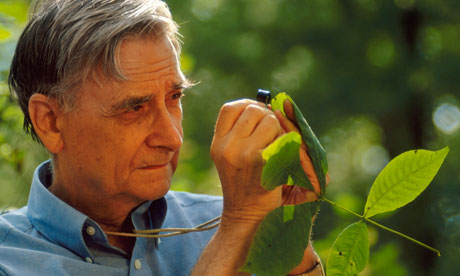The religious impulse is to love and revere life – often represented as loving God, understood as the creator of life. Harvard biologist Edward O. Wilson offers a single word that sums up the impulse to love life and the healing and reconnection toward which that impulse leads: biophilia (love for life).
 |
| E. O. Wilson |
“To explore and affiliate with life is a deep and complicated process in mental development. To an extent still undervalued in philosophy and religion, our existence depends on this propensity, our spirit is woven from it, hope rises on its currents.” (Wilson 1)We are drawn toward life; we want it to be around us:
“Life of any kind is infinitely more interesting than almost any conceivable variety of inanimate matter.” (84)This attraction toward living things is innate, wired into to us by millions of years of natural selection. It’s who we are, and we cannot build fulfilling and meaningful lives for ourselves – we cannot flourish – without a lot of life around: goldfish and houseplants at the least.
“We are in the fullest sense a biological species and will find little ultimate meaning apart from the remainder of life.” (Wilson 81)Consider the way that humans, whatever their religious background, select habitat for themselves.
“For most of two million years human beings lived on the savannas of Africa, and subsequently those of Europe and Asia, vast, parklike grasslands dotted by groves and scattered trees.” (Wilson 109)The right sort of habitat -- the habitat we were "made for" -- tells us about what is needed for human healing and reconnection. The savanna may not be the only spiritually wholesome habitat for humans, but it does contain these key features: wide open spaces affording a clear view for detecting animals and rival bands at long distance; a few cliffs, hillocks, and ridges which allowed still more distant surveillance and which provided overhangs and caves for shelter at night; scattered clumps of trees; lakes and rivers offering fish, mollusks, and new kinds of edible plants.
* * *
This is part 4 of 6 of "Soteriology: Biophilia"
Next: Part 5: "Small Islands"
Previous: Part 3: "Out from Under Over and Above"
Beginning: Part 1: "Drawing the Line"

No comments:
Post a Comment